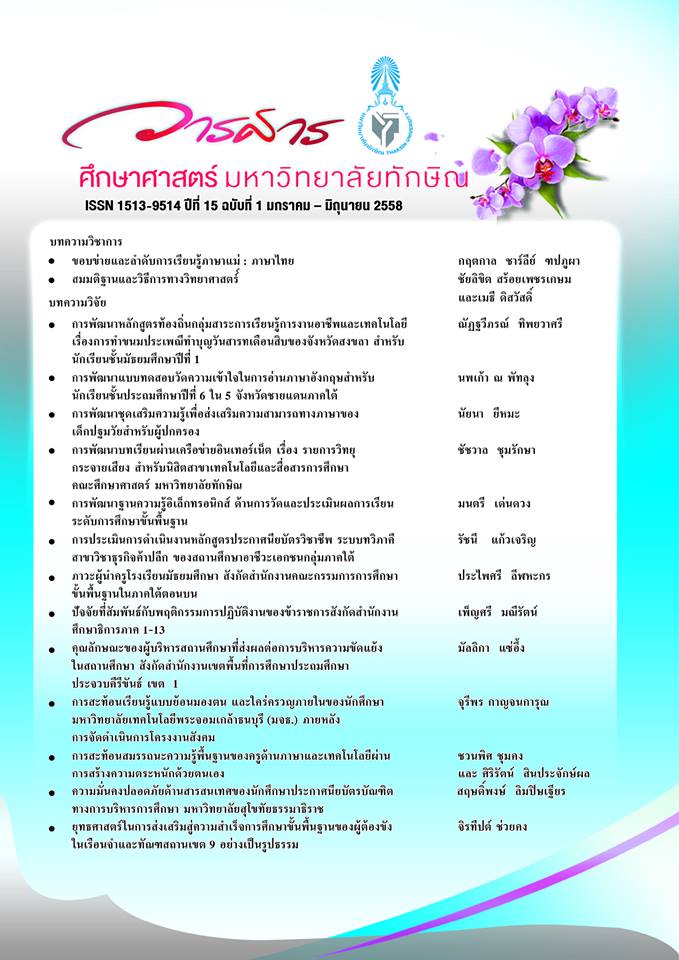การพัฒนาชุดเสริมความรู้เพื่อส่งเสริมความสามารถทางภาษาของเด็กปฐมวัยสำหรับผู้ปกครอง
Main Article Content
บทคัดย่อ
การวิจัยครั้งมีวัตถุประสงค์เพื่อพัฒนาชุดเสริมความรู้เพื่อส่งเสริมความสามารถทางภาษาของเด็กปฐมวัยสำหรับผู้ปกครองและเพื่อหาประสิทธิภาพของชุดเสริมความรู้เพื่อส่งเสริมความสามารถทางภาษาของเด็กปฐมวัยสำหรับผู้ปกครอง กลุ่มตัวอย่างที่ใช้ในการวิจัยเป็นผู้ปกครองนักเรียนชั้นอนุบาลปีที่ 2/2 ภาคเรียนที่ 1 ปีการศึกษา 2556 จำนวน 37 คน โรงเรียนสาธิตมหาวิทยาลัยราชภัฏสงขลาและนักเรียนจำนวน 37 คน เครื่องมือที่ใช้ในการเก็บรวบรวมข้อมูลเป็นเครื่องมือที่คณะผู้วิจัยพัฒนาขึ้นประกอบด้วย 1. ชุดเสริมความรู้เพื่อส่งเสริมความสามารถทางภาษาของเด็กปฐมวัย จำนวน 8 ชุด 2. แบบสังเกตพฤติกรรมสำหรับครู แบ่งเป็น 4 ด้าน คือ ด้านการฟัง การพูด การอ่านและการเขียน 3. แบบทดสอบความสามารถทางภาษาของเด็กปฐมวัย จำนวน 20 ข้อ โดยมีค่าความเชื่อมั่นเท่ากับ 0.85 4. แบบสอบถามการใช้ชุดเสริมความรู้เพื่อส่งเสริมความสามารถทางภาษาของเด็กปฐมวัย 5.แบบสอบถามประเมินโครงการการใช้ชุดเสริมความรู้เพื่อส่งเสริมความสามารถทางภาษาของเด็กปฐมวัย การเก็บรวบรวมข้อมูลดำเนินการโดยคณะผู้วิจัย เก็บรวบรวมข้อมูลทั้งก่อนและหลังการนำชุดเสริมความรู้เพื่อส่งเสริมความสามารถทางภาษาของเด็กปฐมวัยสำหรับผู้ปกครองไปใช้กับนักเรียนครบทั้ง 8 ชุด การวิเคราะห์ข้อมูลเป็นการหาประสิทธิภาพของชุดเสริมความรู้เพื่อส่งเสริมความสามารถทางภาษาของเด็กปฐมวัยและวิเคราะห์ด้วยสถิติ ร้อยละ ค่าเฉลี่ย ค่าความเบี่ยงเบนมาตรฐานและทดสอบความแตกต่างของค่าเฉลี่ยด้วยการทดสอบที t-test ผลการวิจัยสรุปได้ดังนี้
1. ชุดเสริมความรู้เพื่อส่งเสริมความสามารถทางภาษาของเด็กปฐมวัยสำหรับผู้ปกครองที่คณะผู้วิจัยพัฒนาขึ้นครั้งนี้ ประกอบด้วยชุดเสริมความรู้เพื่อส่งเสริมความสามารถทางภาษาของเด็กปฐมวัยสำหรับผู้ปกครอง จำนวน 8 ชุด แต่ละชุดมีจำนวน 2 กิจกรรม แต่ละกิจกรรมประกอบด้วย ชื่อชุดเสริมความรู้ ตารางการทำกิจกรรม คำอธิบายเกี่ยวกับชุดกิจกรรม ชื่อกิจกรรม จุดประสงค์ของ สื่อ/อุปกรณ์ แบบสอบถามผู้ปกครองและอุปกรณ์สำหรับปฏิบัติกิจกรรม
2. ชุดเสริมความรู้เพื่อส่งเสริมความสามารถทางภาษาของเด็กปฐมวัยสำหรับผู้ปกครอง มีประสิทธิภาพกระบวนการ (E1) เป็นไปตามเกณฑ์ ส่วนประสิทธิภาพผลลัพธ์ (E2) เป็นไปตามเกณฑ์ คือ ค่าเฉลี่ยร้อยละของความสามารถทางภาษาของเด็กปฐมวัยเท่ากับ 92.43 โดยที่เด็กปฐมวัยกลุ่มทดลองที่ได้รับการเสริมความรู้ด้วยชุดเสริมความรู้ฯ มีความสามารถทางภาษาสูงกว่าก่อนได้รับการเสริมความรู้อย่างมีนัยสำคัญทางสถิติที่ระดับ .05 ทั้งด้านการฟัง พูด อ่าน เขียน และโดยภาพรวม และหลังการทดลองเด็กปฐมวัยกลุ่มทดลองมีความสามารถทางภาษาแตกต่างกับเด็กปฐมวัยกลุ่มควบคุม อย่างมีนัยสำคัญทางสถิติที่ระดับ .05 ทั้งด้านการพัง พูด อ่าน เขียน และโดยภาพรวม นอกจากนี้ ค่าเฉลี่ยพฤติกรรมของเด็กปฐมวัยกลุ่มทดลองในทัศนคติของผู้ปกครองและครูก่อนและหลังใช้ชุดเสริมความรู้ฯ แตกต่างกันอย่างมีนัยสำคัญทางสถิติที่ระดับ .05 ทั้งด้านการฟัง พูด อ่านและเขียน
Language Supplementary Materials promoting pre-school students’ language ability employed by the parents.
Naiyana Yeema1* ,Puksannat Hoysaku2 and Rasdao Sukkhamat3
This research was aimed at developing supplementary materials for the parents to promote pre-school students’ language ability and to determine the efficiency of language supplementary materials. The sample for the study comprised two groups: the experiment group and the control group. The previous group consisted of 37 parents and 37 second year kindergarten children (room 2) attending Songkhla Rajabhat Laboratory School during the first semester of the 2013 academic year. Likewise, the latter group consisted of 36 parents and 36 second year kindergarten children (room 1) attending Songkhla Rajabhat Laboratory School during the first semester of the 2013 academic year. Five instruments were used to collect data in this present study: 1) The eight sets of language supplementary materials for promoting pre-school students’ language ability; 2) Behavior observing questionnaire for teachers to estimate students’ four skills (listening, speaking, reading, and writing); 3) Language assessment test, with the respective reliability of 0.85; 4) The adoption of materials questionnaire; 5) The program’s assessment questionnaire. The percentage, arithmetic mean and standard deviation were used to analyze the efficiency of the materials and questionnaires. In addition, the t-test was used to analyze the data in order to assess the pre-school students’ language ability before and after using the language supplementary materials. The results of the research were summarized as the following:
1. The language supplementary materials consisted of 8 sets in which comprised two activities for each. ‘The name of material,’ ‘schedule of activities,’ ‘procedures,’ ‘objectives,’ ‘materials,’ and ‘questionnaire for parents’ were included in each activity.
2. The efficiency of the language supplementary materials was stated as follows:
- In term of the process efficiency (E1), the result was in accordance with the criteria. The 100 percentages of the parents employed all eight sets of the materials with their children. According to the product efficiency (E2), the result showed that the students’ language ability in four skills (listening, speaking, reading, and writing) of the experiment group was significantly higher at the 0.05 level after using the materials.
- The students’ language ability in four skills of the experiment group was significantly higher than that of the control group at the 0.05 level.
- Additionally, after the language supplementary materials were employed by the parents, the mean of the students’ behavior in the experiment group was significantly higher at the 0.05 level.
Article Details
ในกรณีที่กองบรรณาธิการ หรือผู้เชี่ยวชาญ ซึ่งได้รับเชิญให้เป็นผู้ตรวจบทความวิจัย หรือ บทความทางวิชาการมีความเห็นว่าควรแก้ไขความบกพร่อง ทางกองบรรณาธิการจะส่งต้นฉบับให้ ผู้เขียนพิจารณาจัดการแก้ไขให้เหมาะสมก่อนที่จะลงพิมพ์ ทั้งนี้ กองบรรณาธิการจะยึดถือความคิด เห็นของผู้เชี่ยวชาญเป็นเกณฑ์


